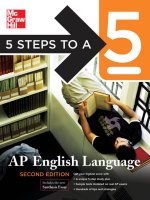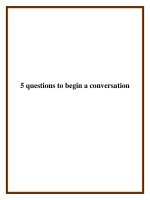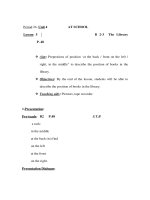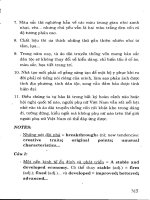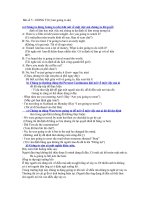4 6 5 welcome to space camp (nonfiction)
Bạn đang xem bản rút gọn của tài liệu. Xem và tải ngay bản đầy đủ của tài liệu tại đây (3.1 MB, 8 trang )
Reader
Genre
Nonfiction
Build Background
Access Content
Extend Language
• The Moon
• Space Camp
• The Solar
System
• The Space
Program
• Definitions
• Labels and
Captions
• Fact Boxes
• Diagram
• Suffix -less
Scott Foresman Reading Street 4.6.5
ì<(sk$m)=becbgd< +^-Ä-U-Ä-U
ISBN 0-328-14216-6
by Mary Kate O’Day
Talk About It
1. How does the diagram on page 7 help you
understand what a space shuttle is like?
2. How does a space camp help people understand
the job of astronauts?
Write About It
3. On a separate sheet of paper, make a T-chart of
facts and opinions about space camp.
by Mary Kate O’Day
Facts
Opinions
Astronauts weigh less on
the moon.
The control center team’s
work is just as important
as the work of the
astronauts.
Extend Language
The suffix -less can be attached to a word to make a
new word. Name and -less make nameless. Nameless
means “without a name.” Windless means “without
wind.” In space many objects are weightless. What
does weightless mean?
Photographs
Every effort has been made to secure permission and provide appropriate credit for photographic material. The
publisher deeply regrets any omission and pledges to correct errors called to its attention in subsequent editions.
Cover ©U.S. Space & Rocket Center; Cover–12 (Bkgd) ©Getty Images; ©Joseph Sohm/
Corbis; 2 ©Corbis; 3 ©Corbis; 4 ©Richard T. Nowitz; 5 ©NASA/Roger Ressmeyer/Corbis;
6 ©Joseph Sohm/Corbis; 7 ©Ricky Blakely/DK Images; 8 ©U.S. Space & Rocket Center;
9 ©U.S. Space & Rocket Center; 10 ©U.S. Space & Rocket Center; 11 ©Richard T. Nowitz/
Corbis; 12 ©Getty Images.
ISBN: 0-328-14216-6
Copyright © Pearson Education, Inc.
All Rights Reserved. Printed in the United States of America.
This publication is protected by Copyright, and permission should be obtained from
the publisher prior to any prohibited reproduction, storage in a retrieval system,
or transmission in any form by any means, electronic, mechanical, photocopying,
recording, or likewise. For information regarding permission(s), write to: Permissions
Department, Scott Foresman, 1900 East Lake Avenue, Glenview, Illinois 60025.
Editorial Offices: Glenview, Illinois • Parsippany, New Jersey • New York, New York
1234
5 6 7Offices:
8 9 10 Needham,
V0G1 14 13
12 11 10 09 08
07 06 05
Sales
Massachusetts
• Duluth,
Georgia • Glenview, Illinois
Coppell, Texas • Sacramento, California • Mesa, Arizona
space shuttle
Astronauts weigh less on the Moon, so they bounce as
they walk.
In July 1969, three astronauts traveled to the
Moon. Two of the astronauts, Neil Armstrong
and Buzz Aldrin, walked on the Moon. The other
astronaut, Michael Collins, circled the Moon in
the spacecraft.
Alone in space, Neil and Buzz landed their tiny
lunar module on the Moon. There were rocks
everywhere. Since there is no air on the Moon,
there was no wind. They felt lighter than on
Earth. Their first job was to learn to walk on the
Moon.
spacecraft: a vehicle used for flight in space; spaceship
2
Today, spaceships
go far beyond
the Moon. But
before spacecraft
could travel into
space, scientists
had to find a way
to escape Earth’s
gravity.
rockets
Rockets help spacecraft
escape Earth’s gravity.
Did You Know?
Gravity
Gravity is a force that draws or pulls smaller objects
toward larger objects in space. Gravity keeps the
Moon traveling around Earth in an orbit. On Earth,
gravity pulls objects and people toward the center
of the Earth.
So how does anything ever leave Earth? Spacecraft
use powerful rockets to escape Earth’s gravity.
orbit: a circular or an egg-shaped path that one object
follows around another object
rockets: machines that use fuel and gas to force a
spacecraft upward into space
3
Did You Know?
Simulation Activities
Astronauts spend many months preparing for space
travel. They do activities that simulate work in space.
A simulator is a piece of equipment that lets
astronauts practice the things they need to do in
space. Astronauts must learn to stay alive in space
where there is no air to breathe. They take air with
them from Earth. They have to learn how to move in
space. They have to learn how to work in space. They
have to learn how to eat and sleep in space.
There is very little gravity in a spaceship. Astronauts
float in the air. During simulation activities,
astronauts learn to work while floating.
Would you like to enjoy an astronaut’s
experience without leaving Earth? You can do it
at a space camp.
Astronauts need to prepare before they go
on a space flight. To prepare themselves, they do
simulation activities. At space camp, you will do
simulation activities, too. But first, you will need
to prepare for them. You will begin by watching
demonstrations. You will play games and do
experiments with other campers.
After that, you will be ready to try out the
same simulation activities astronauts do to
prepare for space travel. These simulations let
you experience what astronauts feel in space.
simulation activities: activities like those done in space
4
simulate: act like; pretend to be like
5
flight deck
mid deck
wing
At space camp, campers use simulators like those used
by astronauts.
Diagram of a space shuttle
Astronauts must learn to walk, work, sleep,
and eat in zero gravity. Food floats in the air.
Sometimes astronauts have to catch it to eat
it. Sometimes they squeeze their food out of a
tube, right into their mouth!
At space camp, you practice doing things in
zero gravity. At some camps you can use a 1/6th
gravity chair. In the 1/6th gravity chair, you will
feel like you are walking on the moon.
In a weightlessness simulator, you will float and
walk as you would float and walk in space. You
feel weightless—as if you weight nothing. These
are some of the simulators you can use at camp.
Your space camp may have a full-scale copy
of a space shuttle. A space shuttle is a reusable
spacecraft with wings. The wings let astronauts
control the landing on Earth. You can climb
aboard the replica and work inside it.
Inside the replica, you will explore the flight
deck where the astronauts control the spacecraft.
You will see the mid deck where much of the
other work is done. As you explore the decks,
you will learn about the many jobs an astronaut
has to do in space.
full-scale: same size as the original
reusable: able to be used again and again
zero gravity: condition of weightlessness
6
replica: copy
7
Sometimes campers can experience a space
mission. During this part of space camp you work
in teams of six.
One team works in the control center outside
the shuttle. This team is like the team of scientists
who stay on Earth during a real mission to space.
Their work is just as important as the work of
the astronauts in the spacecraft. These scientists
control many of the things that happen in space
during a mission.
The other team works inside the shuttle. They
use the controls, make decisions, and follow orders.
mission: trip with a goal or a job to do
8
The teams do everything that must be
done on a real mission. They must launch the
spacecraft and put it into orbit. Every real mission
to space has experiments and other jobs to do.
So the teams do jobs and experiments to learn
about the universe and outer space.
There is a lot of work to do in the control
center, too. The teams must work together to get
the shuttle safely back to Earth. The jobs require
teamwork. That is why astronauts finish the
workshops and use the simulators before going
into space. Everything they learn is used during
the mission into space.
universe: everything that exists everywhere, even in
outer space
9
At some space
camps, you can
see rockets and
spacecraft used
by real astronauts
in space. At other
space camps,
you will study a
model of the solar
system—our sun
and its planets.
You may learn
the history of
space exploration
in a movie or
a multimedia
A multimedia production
production.
uses sound, images, and
You probably
sometimes actors.
will learn about
Galileo and Newton—two men who explored
space from Earth long ago.
Did You Know?
Galileo and Newton
• Galileo Galilei lived in Italy from 1564 to 1642. He
improved early telescopes. A telescope lets you
see faraway objects as though they are close. In
1610 he discovered four moons orbiting the
planet Jupiter.
• In 1642, Sir Isaac Newton was born in England.
Newton defined the laws of gravity. He also
built a new kind of telescope and explained the
movements of planets and their moons.
10
At space camp, you will learn to sleep and eat
as you would in space. You may eat freeze-dried
space food.
Space camps let you try many different
activities. Some camps let you build and launch
a small rocket. At other camps, you can build
and operate a robot. You may learn how to stay
alive or perform experiments. All these activities
let you feel what it is like to be an astronaut in
space.
freeze-dried: food from which all the water has been
removed by freezing
11
Talk About It
1. How does the diagram on page 7 help you
understand what a space shuttle is like?
2. How does a space camp help people understand
the job of astronauts?
Write About It
3. On a separate sheet of paper, make a T-chart of
facts and opinions about space camp.
Facts
Opinions
Astronauts weigh less on
the moon.
The control center team’s
work is just as important
as the work of the
astronauts.
Extend Language
The suffix -less can be attached to a word to make a
new word. Name and -less make nameless. Nameless
means “without a name.” Windless means “without
wind.” In space many objects are weightless. What
does weightless mean?
Photographs
Every effort has been made to secure permission and provide appropriate credit for photographic material. The
publisher deeply regrets any omission and pledges to correct errors called to its attention in subsequent editions.
Cover ©U.S. Space & Rocket Center; Cover–12 (Bkgd) ©Getty Images; ©Joseph Sohm/
Corbis; 2 ©Corbis; 3 ©Corbis; 4 ©Richard T. Nowitz; 5 ©NASA/Roger Ressmeyer/Corbis;
6 ©Joseph Sohm/Corbis; 7 ©Ricky Blakely/DK Images; 8 ©U.S. Space & Rocket Center;
9 ©U.S. Space & Rocket Center; 10 ©U.S. Space & Rocket Center; 11 ©Richard T. Nowitz/
Corbis; 12 ©Getty Images.
ISBN: 0-328-14216-6
Do you think that it would be exciting to
explore the whole universe? We cannot do
that, but you can find out about it at space
camp. Space camp can teach you about space
exploration. Maybe one day, you will be
an astronaut!
12
Copyright © Pearson Education, Inc.
All Rights Reserved. Printed in the United States of America.
This publication is protected by Copyright, and permission should be obtained from
the publisher prior to any prohibited reproduction, storage in a retrieval system,
or transmission in any form by any means, electronic, mechanical, photocopying,
recording, or likewise. For information regarding permission(s), write to: Permissions
Department, Scott Foresman, 1900 East Lake Avenue, Glenview, Illinois 60025.
1 2 3 4 5 6 7 8 9 10 V0G1 14 13 12 11 10 09 08 07 06 05

